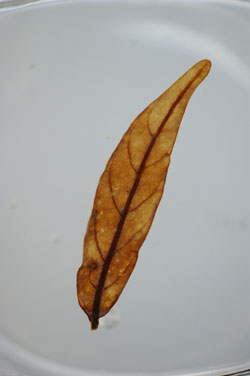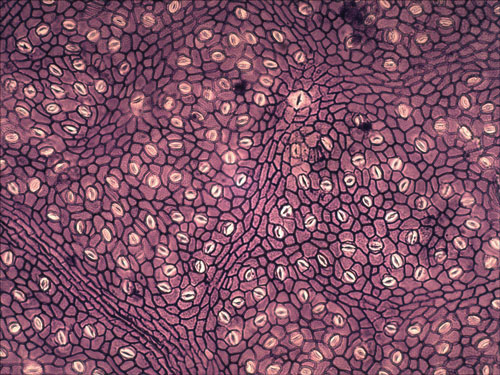From the surface, the fossil deposit of Foulden Maar looks like a typical New Zealand sheep paddock. But the ground beneath it contains both a world-class collection of leaf fossils and a 120,000-year record of Earth’s climate during the Miocene, 23 million years ago.
Those features have allowed international researchers to show, for the first time, that carbon dioxide levels in the atmosphere during that period were relatively high and that some plants could harvest that atmospheric carbon more efficiently for photosynthesis, leading to increased growth and more drought tolerance. This insight has important implications for what we can expect later this century as the climate warms.
Foulden Maar was formed as magma rising through schist came in contact with groundwater, causing a catastrophic explosion. When the dust settled, the eruption had created a very deep, circular crater that became a rain forest–ringed lake. Every spring, diatoms (freshwater algae) bloomed, died, and sank to the anoxic lake bottom, covering the remains of other plants and animals—flowers, spiders, beetles, dragonflies, orchids, fruit, ferns, fish—in a fine, dark-colored shroud.

Their tomb remained largely undisturbed until the 20th century, when small-scale mining started on the site. Study coauthor Daphne Lee from the University of Otago in New Zealand first collected fossils there in the late 1970s, but it wasn’t until she led a geoscience field trip to Foulden Maar in 2003 that scientists realized its full significance. Miners had exposed a vertical face with a digger, and geologists noticed the bar code–like pattern of dark and white layers left by the annual algal blooms. “It’s the most fantastic climate signal,” Lee said.
In 2009, researchers from Otago drilled a core 183 meters into the maar and realized that those annual layers continued for 120 meters—covering a period of about 120,000 years.
Scientists discovered leaves trapped in the layers that were so perfectly preserved they could barely distinguish them from their modern relatives. “You can pick one of these layers and open it like a newspaper, and the leaf just pops out,” said Tammo Reichgelt, an assistant professor of geosciences at the University of Connecticut and lead author of the new study. Reichgelt was based at Columbia University’s Lamont-Doherty Earth Observatory at the time of the study.
Every vein, every stoma, was preserved by the maar—and because the leaves had been essentially mummified in the anaerobic lake sediments before they were fossilized, they also retained some of their chemical composition. “They’re basically pickled,” said Lee.
Another piece of geological luck was the fact that the rocks on the lake bottom were volcanic. Using radiometric dating, volcanic rocks can be dated more precisely than sedimentary rocks. “It’s a perfect storm of circumstances that make Foulden Maar so special,” said Reichgelt. “On top of that, 23 million years ago was actually an extremely interesting time in Earth’s history.”
Smoking Gun
Using a variety of different proxies, scientists estimate that average global temperatures during the Miocene were 5°C or 6°C warmer than today. The Antarctic ice sheet was larger, though, and then rapidly melted over a period of 100,000 years to about half of its current size.
Until recently, most proxies have indicated that carbon dioxide (CO2) levels in the atmosphere during the Miocene were around 300 parts per million, comparable with modern preindustrial levels. This estimate seemed something of a paradox, given what we know about higher CO2 concentrations resulting in warmer temperatures.
Foulden Maar offers a new window on this important period.
For the study, published in August in the journal Climate of the Past, Reichgelt and his colleagues analyzed the carbon composition in 72 fossil leaves found in Foulden Maar, representing 18 tree species. They also mapped the density of their stomata: When CO2 levels are higher, plants can get the carbon they need from fewer stomata, meaning they also lose less water through the open pores and can grow in drier locations.

Put together, the results indicated that in the early Miocene, atmospheric CO2 shifted from 450 to 550 parts per million and then back to 450 parts per million over the 100,000 years represented in the Foulden Maar deposit.
“That seems like a smoking gun to us: an increase in carbon dioxide that was responsible for a temperature increase that then led to the Antarctic deglaciation,” Reichgelt said.
The leaf analysis also showed that plants became both more productive and water use efficient as CO2 levels increased.
No Panacea
The new research is the first time a study has brought together those three elements—CO2, plants’ photosynthetic rate, and water use efficiency—for one site, said Dana Royer, a professor of Earth and environmental sciences at Wesleyan University in Connecticut. He codeveloped the Franks model the authors used to model leaf gas exchange but was not involved in the study.
“The information that they’re providing is very useful for understanding how these ecosystems function, how ecosystems are responding to CO2, how this fits into the context of present-day climate change,” Royer said.
Human emissions have now increased atmospheric CO2 concentrations to around 415 parts per million and are predicted to hit 450 parts per million—comparable to those experienced by the Foulden Maar forest—by as early as 2030 or 2040.
There are already indications that higher CO2 is increasing plants’ leaf volume and making the Earth greener. But that’s not necessarily good news, Reichgelt warned.
Any increased carbon storage won’t compensate for fossil fuel emissions. From a human nutrition perspective, several studies have shown that although higher CO2 levels might increase crop yields, they result in less-nutrient-dense food, as plants pile on carbon without absorbing extra iron, zinc, or calcium.
Finally, because today’s plants evolved in a relatively low CO2 environment, they may not be able to take advantage of the extra carbon as well as the better adapted Foulden Maar trees were.
Researchers believe that many more insights—about past climates, ecosystems, and evolution—are waiting to be discovered in Foulden Maar’s depths. “Every time we go, we find something new,” Lee said.
Unfortunately, that’s not currently an option. In 2019, a mining company revealed plans to strip-mine the site, hoping to turn the diatomite into lucrative animal feed. The company has since gone bankrupt, and the Dunedin City Council is looking into buying the land to protect it. In the meantime, the company’s receivers have barred scientists from visiting the site.
Although “we haven’t actually saved it, yet,” said Lee, she won’t give up. “Foulden Maar is unique. There is nothing like it.”
—Kate Evans (@kate_g_evans), Science Writer
